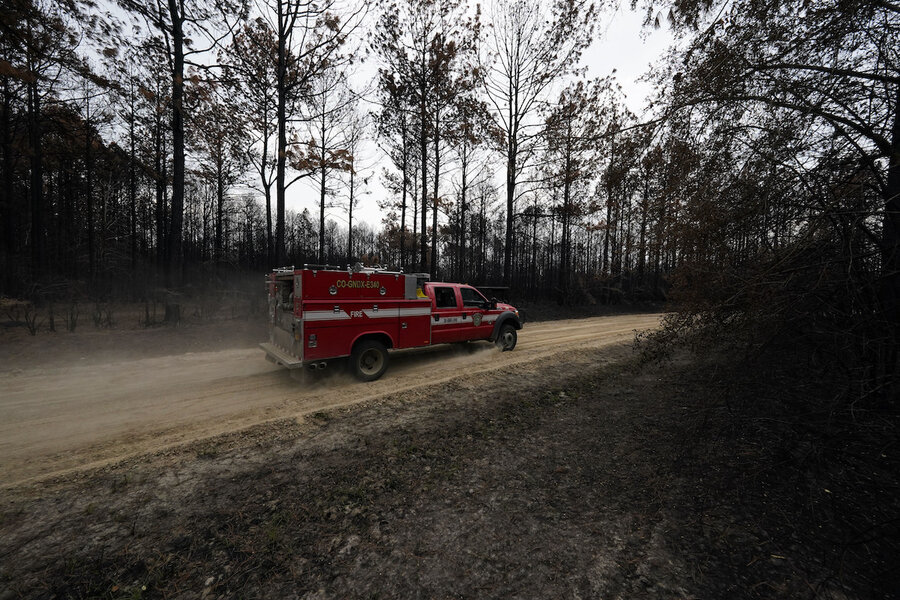Louisiana’s ‘new normal’: Record-breaking wildfires scorch the state
Loading...
| Baton Rouge, La.
Louisiana, typically one of the wettest states in the country, is on fire.
In communities often challenged by flooding and hurricanes this time of year, firefighters instead are fending off 300-foot-tall blazes during an unprecedented wildfire season, which isn’t even halfway over. Stoked by record-breaking heat, drought, and plentiful dry vegetation to fuel the flames, more than 550 fires – in August alone – ravaged tens of thousands of acres of Louisiana land, engulfed homes, and forced entire towns to evacuate.
Louisiana’s excessive wildfire season is just one climate disaster in a summer of weather anomalies that have plagued the country – a tropical storm watch issued for southern California, destructive flooding in the Northeast, and the fatal wildfires in Maui, the deadliest in the country in over a century. More extreme weather events are happening across the globe, from longer, more intense, and more frequent droughts, and heat waves to devastating floods and wetter hurricanes, attributed at least in part to climate change.
And, in Louisiana, some officials fear these once rare occurrences could become more common.
Louisiana’s largest wildfire this season, which has been burning for nearly a month, has scorched more than 31,000 acres – accounting for more burned land than the state usually has in an entire year. Dubbed the Tiger Island Fire, Gov. John Bel Edwards described the blaze as “one of the worst wildfires that we’ve seen since at least the Second World War.” The wildfire, which investigators have determined to be caused by arson, continues to engulf parts of southwestern Louisiana that just three years ago was hit by Hurricane Laura.
The fire forced the entire town of Merryville – a rural area 5 miles east of the Texas border, with a population of 1,200 people – to evacuate. Among those pushed out was Lindsay Bustamante, whose mobile home can be seen in a viral video that shows towering flames abutting her property, inching toward the home until it was swallowed whole. The home is now unlivable and Ms. Bustamante and her two young daughters have been left with trauma and nightmares.
“It’s hard to fall asleep at night, not knowing when we are going to have a fire pop up and just burn us out,” Ms. Bustamante said.
At least 38 structures, including homes and hunting camps, have been destroyed. Luckily, there have not been any reported deaths from the blaze.
But the Tiger Island Fire, which is 80% contained, is just one of hundreds that have ignited in the Bayou State.
Louisiana is abnormally dry for this time of year. In August half of the state faced “extreme” or “exceptional” drought, according to data from the National Oceanic and Atmospheric Administration. In addition, the state faced scorching triple-digit temperatures this summer, forcing Governor Edwards to declare a state of emergency due to the extreme heat. Combined, the conditions have made for an unusually high risk of wildfires.
“Under these conditions ... a wildfire can become a major wildfire, and it only takes a few minutes,” said Mike Strain, the commissioner of the state’s department of agriculture and forestry.
During August, Louisiana’s fires burned more than 60,000 acres – a little larger than the size of Boston, Massachusetts. On average over the past decade, only 8,217 acres of land in Louisiana is burned per year. Mr. Strain said Louisiana is just in the “early-middle” of the wildfire season, which typically ends in December.
To make matters worse, Deep South firefighters in local departments are relatively inexperienced with wildfires and have been stretched thin this summer. As they begin to contain or extinguish one fire, about a dozen others ignite across the state each day. Fire personnel from at least seven other states, have been sent to Louisiana to help control the blazes.
Mr. Strain described the wildfire scenes as a “firestorm,” adding that wind and smoke often carry embers and debris from one blaze, which can travel 8 to 10 miles and cause additional fires.
Officials have pleaded with residents to adhere to a statewide burn ban, stressing that something as small as throwing a cigarette butt out a car window, sparks from dragging safety trailer chains, warm exhaust pipes on grass, or even cooking outside could lead to devastating consequences. However, dozens of burn ban violations have been issued and Mr. Edwards says that many of the wildfires could have been prevented.
While firefighters continue to battle blazes across the state and as officials pray for rain, the wildfire season is far from over. Mr. Edwards warns that heightened wildfire risks in future summers may be the “new normal” for Louisiana and that the state will need additional wildfire response training and equipment to address the issue.
“This is a new normal that we have to be prepared for to a degree, quite frankly, that we just haven’t had to do in the past,” Mr. Edwards said.
This story was reported by the Associated Press.





